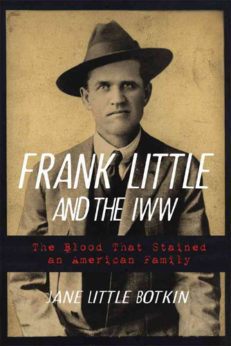
It was August 1, 1917. After organizing a strike of metal miners against the Anaconda Company (Anaconda Copper Mining Company was one of the largest trusts of the early 20th century), Wobbly organizer Frank Little was dragged by six masked men from his Butte, Mont., hotel room and hung from the Milwaukee Railroad trestle.
Why Frank Little and his times matter
Frank Little was a top organizer for the Industrial Workers of the World—the IWW, the Wobblies, the One Big Union or OBU. At the time he was lynched, he was Chairman of the IWW General Executive Board. Not all details are known, but his legacy includes:
- Implementation of passive resistance tactics decades before Gandhi or Rev. Martin Luther King, Jr.
- Organizing itinerant farm workers decades before Cesar Chavez
- Industrial organizing—as opposed to craft organizing—decades before the CIO
- Champion of the argument that workers should stay out of World War I.
If Frank Little had survived his 39th year, and if his ideas had survived, civil rights would have been greatly advanced. Labor would have put aside all arguments against minorities and immigrants long ago. Itinerant farm workers would have been organized far earlier. Divisions in the ranks of organized labor would have melted away. Thousands of soldiers’ lives would have been saved and American workers would have had a far better understanding of capitalism, imperialism, and socialism than they do now or have ever had. This last point is based on Frank Little’s adamant opposition to World War I. He was one of the most outspoken labor leaders in the world on this point. Another was V. I. Lenin in Russia.
Why didn’t we already know all this?
Within a month of Frank Little’s lynching at the hands of the copper bosses of Montana, the United States government launched the fiercest attack against the working class in our history. Free speech, one of Frank Little’s greatest causes, was trampled. Unionists were hunted down and deported or arrested and tortured. Heavy jail sentences were laid on many hundreds railroaded for having “conspired with Frank H. Little” to undermine war production.
Union halls were raided and all records were confiscated. History, especially any history associated with Frank Little, was wiped clean. Fear was so great that even Frank Little’s relatives dared not remember him. The fear silenced his story for almost 100 years, until now.
In 2017, a giant hole in American labor history was filled by Jane Little Botkin in her book, Frank Little and the IWW: The Blood That Stained an American Family.
Frank Little’s great-grandniece has explained every known detail of the great union organizer’s life. A hundred and twenty-five pages of careful research testify to her ability as a historian of the first rank. She also reveals family records hidden for a century. She has written not only the best biography of Frank Little possible, but she also put the events of his life and times in context so that a reader can, from this one book, draw the important lessons of the missing chapters—1905-1919—of American history.
Frank Little and the IWW: The Blood That Stained an American Family
By Jane Little Botkin
University of Oklahoma Press, 2017, Hardcover and Kindle editions












Comments